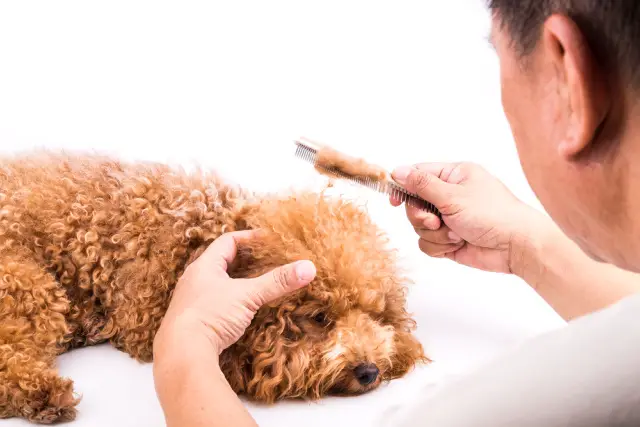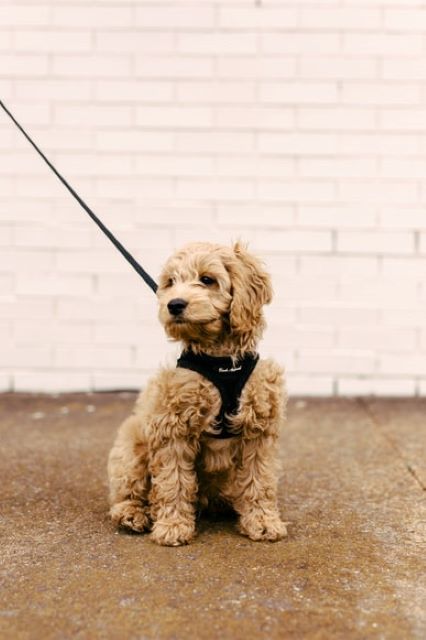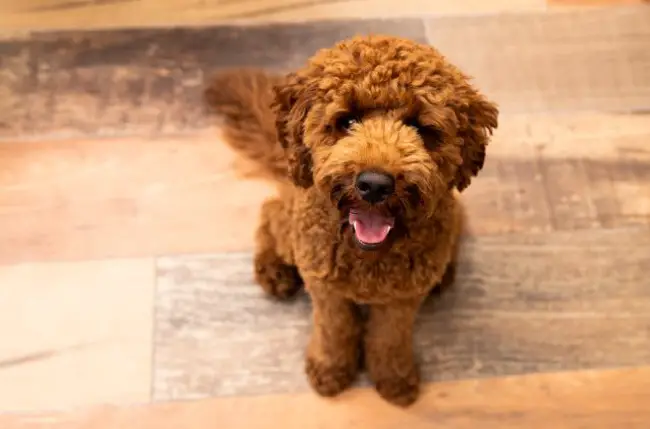Cavapoos are known as a low shed hypoallergenic dog breed. Does this suggest that all Cavapoos shed is identical, or can coat or generation type play a role? Find all the answers here.
All dog breeds shed, but with Cavapoos, the shed amount can vary from little to insignificant. Knowing your Cavapoos genetic makeup can help predict your dog’s coat and shed, but the extent of the shed can only be suitably determined after their first shed cycle.

Related: Cavapoo Colors And Coat Patterns
Do Genetics Play a Role?
You can expect anything from minor to moderate shed from any Cavapoo. You can remove some guesswork by purchasing through a reputable breeder and meeting your pup’s parents beforehand.
The truth is that there is no such thing as a dog breed that is completely nonshedding. All dog breeds shed a little. Fortunately, Cavapoos typically shed very little and are therefore considered a good option for dog owners looking for a hypoallergenic breed.
F1 and F2 Cavapoos
With first and second-generation Cavapoos, the shed is usually unknown as they typically comprise a 50-50 split between Cavalier King Charles Spaniel and Poodle.
Usually, the coat type and shed amount will depend on whether they inherited their dominant genes from their Poodle or Cavalier parent.
Other Cavapoo Generations
Your F1B, F1BB, F2B, and F2BB Cavapoo are typically less shedding because their gene percentage is considerably more Poodle than Cavalier King Charles Spaniel. Although this is not a guarantee of a low shedding dog, the odds are more likely to favor low shedding.
The F2BB generation Cavapoo’s parents are both F1BB Cavapoos. F1BB Cavapoos have around 87 to 88% Poodle genes, making the F2BB generation Cavapoo one of the most popular generation Cavapoos for those looking for low-shedding dogs.
Finally, although also usually low shedding, your multi-generation or F3 generation Cavapoo can still be a bit of an anomaly when predicting the amount of shed.
Cavapoo Coat Type, Shed, and What to Consider
So now that you have an idea of how generation type can influence shed, it’s also good to remember that although your Cavapoo may shed less, coat maintenance may not be lesser.
Poodle Dominant
Cavapoos with a dominant Poodle gene will have shorter, curlier, woolly, lower shedding coats. Coats can also be more on the fleecy side, where they are wavier with a silky loose curl appearance. This wavier coat type usually presents when your Cavapoo gene mix is somewhere between the Poodle and Cavalier.
Although wool and fleece coats are low sheddings, the shed usually remains trapped in the curls and can get matted if not groomed and brushed regularly.
My precious Coco is a first-generation black Cavapoo, and although I never experience any shedding from her, I need to brush her regularly to avoid nasty matting. Brushing also helps remove any dander or dirt that may collect on her skin or cause irritation.
Cavalier Dominant
If your Cavapoo has a wiry coat or longer or finer hair around the neck and face area, it may have more dominant Cavalier genes. The coat on the back and tail area of an adult Cavapoo are usually good indicators of whether your Cavapoo is more Cavalier or Poodle dominant.
Although wiry-coated Cavapoo requires less grooming, they may shed more than a wool or fleece-coated Cavapoo. The coats will also continue growing and need regular cutting to ensure the hair does not grow too long.
It is helpful to understand that although Cavapoos are often labeled wooly, wiry, or fleece-like, these coat types work on a sliding scale, where many Cavapoos fall in between these coat types. This can make the shed and coat maintenance different for each Cavapoo.
Cavapoo Age-Related Shed and Coat Changes
Most Cavapoos start with soft straighter coats, and their coats gradually change as they age.
Puppy Shed

A Cavapoo’s s first shed will be around six months when they shed their puppy coat. This shedding process can take a couple of months and usually results in thicker fur growing back in its place.
The Cavapoo’s puppy shed is usually the most significant shed that a Cavapoo will experience in its lifetime.
Whether the shed is gradual or dramatic varies from Cavapoo to Cavapoo, but with regular grooming, you can reduce the shedding effects tenfold.
After their first shed, you will have a better idea of the coat type your Cavapoo has inherited and whether they are more Poodle or Cavalier-like in terms of the shed. It is helpful to keep in mind that your Cavapoo is not fully developed until they reach around two or three years of age.
Coat changes can still take place up until the time they have reached adulthood.
Aging
As your Cavapoo matures into old age, their coat may become thinner, and the shine or color of their coats may also change.
You can minimize these hair changes by brushing them regularly and providing them with a well-balanced diet and regular exercise. Shedding in old age will typically be more noticeable in Cavapoos that have trouble with their health or wellbeing.
Seasonal Changes
Your Cavapoo, although low shedding, will shed more when seasonal changes occur. When the weather transitions from cold to warm or during the start of spring or winter, Cavapoos can shed more hair than usual.
Some Cavapoos will lose some of their long hairs to accommodate shorter, thicker hair for the colder winter months ahead. The seasonal changes will be less significant if your dog spends most of its time indoors.
Depending on their coat type, this seasonal shed may or may not be noticeable.
Coat Specific Grooming

Because Cavapoos can have various coat types and shed, acquiring the correct brushes and grooming equipment is essential.
For wooly or curly coated Cavapoos, an excellent detangling spray or shampoo, a wire-pin or firm bristle brush, and a slicker brush can help with matts and shedding. The more wiry-haired Cavapoos will also benefit from regular brushing with a slicker brush.
By brushing your Cavapoo regularly, you will avoid any painful matting. Curlier-coated Cavapoos can get matted quickly as the shed, even if only in small quantities, can get trapped in their curls. With insufficient brushing, severe matting and knotting may result.
Cavapoos have a double coat with a protective upper coat and a warmer, softer undercoat to keep them warm in winter and cool in the summer months. Although useful and low shedding, this double coat requires proper maintenance and grooming.
Keep in mind that excess bathing of your Cavapoo can also dry their skins out and increase shedding. Bathing them once every three to four weeks is more than enough and will ensure their natural skin oils are not depleted.
Useful Grooming Supplies
Pet owners highly rate this Hertzko Self-Cleaning Slicker Brush for Dogs. Not only is it easy to clean, but it is excellent for reducing shedding and tangles and maintaining a healthy coat.
The Hartz Groomer’s Best Combo Dog Brush is also a great essential brush combo that helps with tangles and promotes a healthier coat. This brush works well for all coat types, whether your Cavapoo’s coat is long, short, curly, or wire-haired.
Finally, another useful product to keep on hand at home would be the TropiClean Sweet Pea Tangle Remover Spray for Pets. It reduces your doggy brush time, making brushing gentler for your Cavapoo, and aids in preventing any nasty mats from forming.
Related Reading:
- Do Double Doodles Shed Hair? (Answered!)
- Do Cavapoo Puppies Start With Straight Hair?
- What Age To Start Grooming Cavapoo Puppy
- What To Do If Your Cavapoo Hates Grooming: 16 Tips!
- Cavapoo Generations F1, F1b, F1bb, F2, F3 Explained
- Are Cavapoos High-Maintenance?
- Danoodle Dogs: Pros and Cons | Should You Get One?
- Schnoodle Coat Types And How To Care For Them
